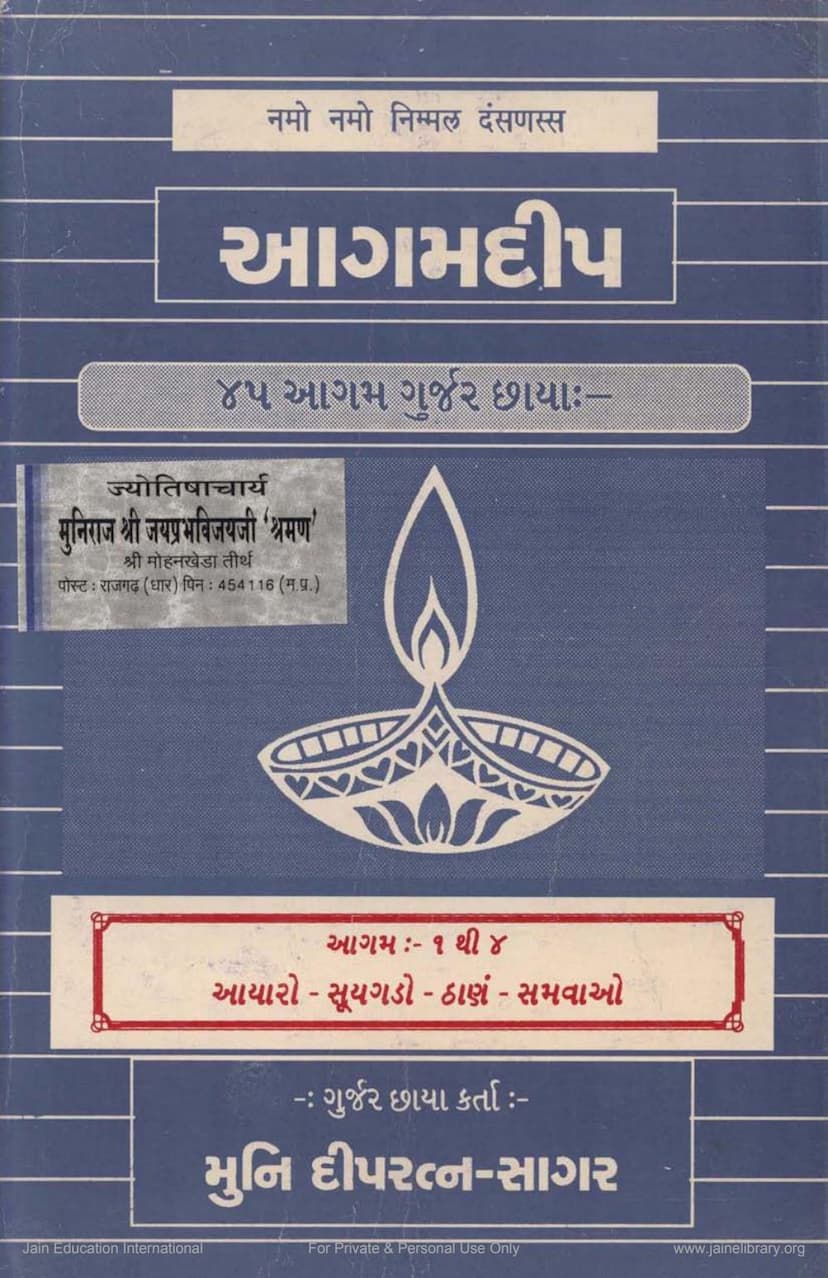Agam Deep 01 Ayaro Gujarati Anuvaad
Added to library: September 1, 2025

Summary
The provided text is a Gujarati translation and commentary of the first Jain Agam (scripture), specifically the Āyārāṅga Sūtra, part of the Śvetāmbara canon. The title of the work is "Āgam Dīpa 01 Āyāro Gujarati Anuvaad," authored by Dipratnasagar and Deepratnasagar, and published by Agam Shrut Prakashan. The catalog link and publisher information indicate it is a Jain religious text focused on scripture.
The text details the content and philosophical underpinnings of the Āyārāṅga Sūtra, particularly focusing on the conduct and discipline of monks. It is presented as a detailed analysis and explanation in Gujarati, with the commentary being in "Gurjar Chhaya" (Gujarati shadow/explanation) by Muni Deepratna Sagar.
Here's a breakdown of the key themes and information conveyed across the pages:
Core Jain Principles and Monastic Discipline:
- Emphasis on Non-Violence (Ahimsa): A significant portion of the text, especially in the early chapters of Āyārāṅga, elaborates on the inherent life in all entities (earth-bodied, water-bodied, fire-bodied, air-bodied, plant-bodied, and mobile beings). It stresses the importance of avoiding harm to any living being, regardless of its perceived sensory capabilities or physical form. The text details how various actions, even seemingly mundane ones, can lead to violence and karma accumulation.
- The Six Un-living Entities (Ṣaṭkāya): The text repeatedly refers to the six categories of living beings (earth-bodied, water-bodied, fire-bodied, air-bodied, plant-bodied, and mobile beings) and the strict adherence required to avoid harming them.
- Karma and its Accumulation: The text frequently explains how actions (karma) bind the soul and lead to rebirth. It emphasizes that understanding the causes and effects of karma is crucial for liberation.
- Purity of Conduct (Āchāra): A central theme is the meticulous conduct expected of Jain monks. This includes guidelines on:
- Alms-taking (Piṇḍēṣaṇā): Strict rules are laid down regarding the acceptance of food and drink, ensuring it is pure, un-solicited, and free from any taint of violence or attachment. The text details what is acceptable and what is to be avoided.
- Dwelling (Avagraha): Guidelines for selecting and inhabiting places of stay are provided, emphasizing avoidance of places that are the abode of or frequented by insects, animals, or where improper activities might occur. The text discusses the doshas associated with different types of dwellings and how to maintain purity.
- Movement (Iyyā Samiti): Strict adherence to careful movement is stressed, avoiding harm to living beings on the path, and maintaining mindfulness.
- Speech (Bhāṣā Samiti): The importance of truthful, non-harmful, and appropriate speech is highlighted, with examples of what to say and what to avoid.
- Mindfulness and Control of Senses (Indriyas): The text repeatedly emphasizes the need for controlling the senses and mind, avoiding attachment to sensory pleasures, and remaining detached from worldly desires.
- Renunciation (Tyāga): The path of renunciation and detachment from worldly possessions and relationships is presented as the ultimate means to liberation.
- The Nature of the Soul and Liberation: The text touches upon the true nature of the soul and the path to liberation (moksha) through right faith, knowledge, and conduct.
Structure and Content of the Āyārāṅga Sūtra as presented:
The text systematically breaks down the Āyārāṅga Sūtra into its various divisions and chapters, providing a table of contents and then delving into the details of each section.
- Angas and Upangas: The text refers to the 12 Angas and 12 Upangas of Jain scripture, indicating that the Āyārāṅga Sūtra is the first Anga. The title and page listings also show the breakdown of the Āyārāṅga Sūtra into its major divisions like Śrutaskandha-1 and various Adhyayanas (chapters) and Udesas (sections/lessons).
- Detailed Explanations of Rules: The commentary provides specific explanations for monastic rules concerning:
- Dietary restrictions: What kind of food, drink, and materials are permissible for monks.
- Clothing and possessions: Strict limitations on the number and type of belongings a monk can possess.
- Interactions with the laity and other ascetics: Guidelines on how monks should interact with householders and members of other religious traditions.
- Dealing with hardship and afflictions (Pariṣaha): The text emphasizes the endurance of various hardships like hunger, thirst, cold, heat, insect bites, etc., with equanimity.
- The process of death (Pandita Marana): The text discusses various forms of intentional death (like fasting) as a means of karma purification and achieving liberation.
- The importance of the Guru and spiritual lineage: The text implies the significance of following the teachings of the Guru and the tradition.
Specific Concepts and Terminology:
- Jain Cosmology: While not explicitly detailed, references to directions, directions (vidisha), celestial beings, and realms suggest an understanding of Jain cosmology.
- Key Terms: The text uses many specific Jain terms such as nirgrantha (ascetic), anagar (homeless one), samiti (careful conduct), gupti (restraint), pariṣaha (afflictions), adhyayana (chapter), uddesa (section), karma, moksha, tiryak, sthāvara, trasa, etc.
Publisher and Sponsorship:
The text also highlights the sponsors and patrons of this publication, including "Agam Shrut Prakashan," and individuals and families who have financially supported the project (e.g., Smt. Naynaben Rameshchandra Shah family). This suggests a collaborative effort within the Jain community to preserve and disseminate religious knowledge.
Overall Purpose:
The primary purpose of this work is to provide a comprehensive and accessible explanation of the foundational Āyārāṅga Sūtra in Gujarati, enabling Jain followers, especially ascetics and those interested in monastic life, to understand and practice the principles of Jainism as laid down in this ancient scripture. It serves as a guide for rigorous spiritual discipline and ethical conduct.